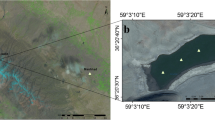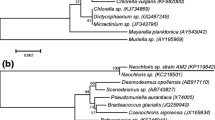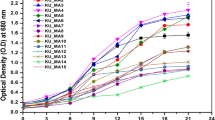Abstract
Natural-based chemicals from microalgae such as lipids and pigments are the interests in industries and the bioeconomy. Cold-adapted Ankistrodesmus sp. OR119838, an isolated strain from Cheshmeh–Sabz Lake in northeastern Iran, was cultivated using a two-stage culture strategy under different environmental conditions. With doubling the nitrate concentration at the vegetative stage (170 mg/L) and increasing the light intensity (180 µmol photons/m2/s) the highest specific growth rate (0.61 ± 0.02 per day) and biomass productivity (121.1 ± 7.2 mg/L/day) were observed at 25 °C. In the optimal growth condition Chl a and Chl b contents of Ankistrodesmus sp. OR119838 reached the highest amount (11.07 ± 0.14 and 11.23 ± 0.29 µg/mL, respectively) at 25 °C. While carotenoid content correlated negatively with optimum biomass productivity (− 0.708) and had the best value (12.23 ± 0.29 µg/mL) in nitrogen deficiency (42 mg/L) and intense light conditions (180 µmol photons/m2/s) at 15 °C. Lipid content was increased with declined nitrate concentration (42 mg/L), high light intensity, and 180 µmol photons/m2/s at 25 °C. The highest percentage of polyunsaturated fatty acids (71.94%) and α-linolenic acid (57.73 ± 6.63%) was observed in conditions with 170 mg/L nitrate concentration and low light intensity (40 µmol photons/m2/ s) at the low temperature (15 °C). While saturated fatty acids content (43.27%) and palmitic acid reached the highest amount under 40 µmol photons/m2/s, 42 mg/L nitrate at 25 °C (35.02 ± 5.33%). Biomass productivity of Ankistrodesmus sp. OR119838, as a cold-adapted strain, decreased by only 8.2% with a 10-degree decline in temperature. Therefore, this strain has good potential to grow in open ponds by tolerating the daily temperature fluctuations.




Similar content being viewed by others
Data availability
The datasets generated during the current study are available from the corresponding authors upon request.
References
Ferreira de Oliveira AP, Bragotto APA (2022) Microalgae-based products: Food and public health. Futur Foods 6:100157. https://doi.org/10.1016/j.fufo.2022.100157
Dolganyuk V, Belova D, Babich O et al (2020) Microalgae: A promising source of valuable bioproducts. Biomolecules 10:1153. https://doi.org/10.3390/biom10081153
Mehariya S, Goswami RK, Karthikeysan OP, Verma P (2021) Microalgae for high-value products: a way towards green nutraceutical and pharmaceutical compounds. Chemosphere 280:130553. https://doi.org/10.1016/j.chemosphere.2021.130553
Remize M, Brunel Y, Silva J et al (2021) Microalgae n-3 PUFAs production and use in food and feed industries. Mar Drugs 19:113. https://doi.org/10.3390/md19020113
Tang DYY, Yew GY, Koyande AK et al (2020) Green technology for the industrial production of biofuels and bioproducts from microalgae: a review. Environ Chem Lett 18:1967–1985. https://doi.org/10.1007/s10311-020-01052-3
Varela JC, Pereira H, Vila M, León R (2015) Production of carotenoids by microalgae: achievements and challenges. Photosynth Res 125:423–436. https://doi.org/10.1007/s11120-015-0149-2
Barkia I, Saari N, Manning SR (2019) Microalgae for high-value products towards human health and nutrition. Mar Drugs 17:304. https://doi.org/10.3390/md17050304
Maltsev Y, Maltseva K, Kulikovskiy M, Maltseva S (2021) Influence of light conditions on microalgae growth and content of lipids, carotenoids, and fatty acid composition. Biology (Basel) 10:1060. https://doi.org/10.3390/biology10101060
He Q, Yang H, Wu L, Hu C (2015) Effect of light intensity on physiological changes, carbon allocation and neutral lipid accumulation in oleaginous microalgae. Bioresour Technol 191:219–228. https://doi.org/10.1016/j.biortech.2015.05.021
Krzemińska I, Piasecka A, Nosalewicz A et al (2015) Alterations of the lipid content and fatty acid profile of Chlorella protothecoides under different light intensities. Bioresour Technol 196:72–77. https://doi.org/10.1016/j.biortech.2015.07.043
Kurpan Nogueira DP, Silva AF, Araújo OQF, Chaloub RM (2015) Impact of temperature and light intensity on triacylglycerol accumulation in marine microalgae. Biomass Bioenerg 72:280–287. https://doi.org/10.1016/j.biombioe.2014.10.017
Lamers P, van de Laak C, Kaasenbrood P et al (2010) Carotenoid and fatty acid metabolism in light-stressed Dunaliella Salina. Biotechnol Bioeng 106:638–648. https://doi.org/10.1002/bit.22725
Xie Y, Ho SH, Chen N et al (2013) Phototrophic cultivation of a thermo-tolerant Desmodesmus sp. for lutein production: effects of nitrate concentration, light intensity and fed-batch operation. Bioresour Technol. https://doi.org/10.1016/j.biortech.2013.06.064
Chodchoey K, Verduyn C (2012) Growth, fatty acid profile in major lipid classes and lipid fluidity of Aurantiochytrium mangroveiSK-02 As a function of growth temperature. Braz J Microbiol 43:187–200. https://doi.org/10.1590/S1517-838220120001000020
Sun XM, Ren L, Zhao Q et al (2018) Microalgae for the production of lipid and carotenoids: a review with focus on stress regulation and adaptation. Biotechnol Biofuels. https://doi.org/10.1186/s13068-018-1275-9
Lindberg A, Niemi C, Takahashi J et al (2022) Cold stress stimulates algae to produce value-added compounds. Bioresour Technol Rep 19:101145. https://doi.org/10.1016/j.biteb.2022.101145
Chokshi K, Pancha I, Ghosh A, Mishra S (2017) Nitrogen starvation-induced cellular crosstalk of ROS-scavenging antioxidants and phytohormone enhanced the biofuel potential of green microalga Acutodesmus dimorphus. Biotechnol Biofuels 10:60. https://doi.org/10.1186/s13068-017-0747-7
Yang L, Chen J, Qin S et al (2018) Growth and lipid accumulation by different nutrients in the microalga Chlamydomonas reinhardtii. Biotechnol Biofuels. https://doi.org/10.1186/s13068-018-1041-z
Potijun S, Yaisamlee C, Sirikhachornkit A (2021) Pigment production under cold stress in the Green Microalga Chlamydomonas reinhardtii. Agriculture. https://doi.org/10.3390/agriculture11060564
Ali H, El-fayoumy E, Rasmy W et al (2021) Two-stage cultivation of Chlorella vulgaris using light and salt stress conditions for simultaneous production of lipid, carotenoids, and antioxidants. J Appl Phycol 33:1–13. https://doi.org/10.1007/s10811-020-02308-9
Sun H, Zhao W, Mao X et al (2018) High-value biomass from microalgae production platforms: strategies and progress based on carbon metabolism and energy conversion. Biotechnol Biofuels 11:227. https://doi.org/10.1186/s13068-018-1225-6
Rearte TA, Figueroa FL, Gómez-Serrano C et al (2020) Optimization of the production of lipids and carotenoids in the microalga Golenkinia aff. brevispicula. Algal Res 51:102004
Mitra M, Patidar SK, Mishra S (2015) Integrated process of two stage cultivation of Nannochloropsis sp. for nutraceutically valuable eicosapentaenoic acid along with biodiesel. Bioresour Technol 193:363–369. https://doi.org/10.1016/j.biortech.2015.06.033
Rezaei A, Cheniany M, Ahmadzadeh H, Vaezi J (2023) Evaluation of lipid composition and growth parameters of cold-adapted microalgae under different conditions. BioEnergy Res. https://doi.org/10.1007/s12155-023-10626-2
Campos M, Faria V, Teodoro T et al (2013) Evaluation of the capacity of the cyanobacterium Microcystis novacekii to remove atrazine from a culture medium. J Environ Sci Health B 48:101–107. https://doi.org/10.1080/03601234.2013.726891
Kong WB, Yang H, Cao YT et al (2013) Effect of glycerol and glucose on the enhancement of biomass, lipid and soluble carbohydrate production by chlorella vulgaris in mixotrophic culture. Food Technol Biotechnol 51(1):62–69
Zhu CJ, Lee YK (1997) Determination of biomass dry weight of marine microalgae. J Appl Phycol 9:189–194. https://doi.org/10.1023/A:1007914806640
Nayek S, Choudhury I et al (2014) Spectrophotometric analysis of chlorophylls and carotenoids from commonly grown fern species by using various extracting solvents. Res J Chem Sci 4:2231–2606
Lari Z, Abrishamchi P, Ahmadzadeh H, Soltani N (2019) Differential carbon partitioning and fatty acid composition in mixotrophic and autotrophic cultures of a new marine isolate Tetraselmis sp. KY114885. J Appl Phycol 31:201–210. https://doi.org/10.1007/s10811-018-1549-4
Roshith CM, Meena DK, Manna RK et al (2018) Phytoplankton community structure of the Gangetic (Hooghly-Matla) estuary: Status and ecological implications in relation to eco-climatic variability. Flora 240:133–143. https://doi.org/10.1016/j.flora.2018.01.001
Cao K, He M, Yang W et al (2016) The eurythermal adaptivity and temperature tolerance of a newly isolated psychrotolerant Arctic Chlorella sp. J Appl Phycol 28:877–888. https://doi.org/10.1007/s10811-015-0627-0
Goldsborough LG, Robinson GGC (1996) 4 - Pattern in Wetlands**Contribution 248 from the University Field Station (Delta Marsh), University of Manitoba, Winnipeg. In: Stevenson RJ, Bothwell ML, Lowe RLBT-AE (eds) Aquatic ecology. Academic Press, San Diego, p. 77–117
Valledor L, Furuhashi T, Hanak AM, Weckwerth W (2013) Systemic cold stress adaptation of Chlamydomonas reinhardtii. Mol Cell Proteomics 12:2032–2047. https://doi.org/10.1074/mcp.M112.026765
Cvetkovska M, Hüner NPA, Smith DR (2017) Chilling out: the evolution and diversification of psychrophilic algae with a focus on Chlamydomonadales. Polar Biol 40:1169–1184. https://doi.org/10.1007/s00300-016-2045-4
Randhir A, Laird DW, Maker G et al (2020) Microalgae: a potential sustainable commercial source of sterols. Algal Res 46:101772. https://doi.org/10.1016/j.algal.2019.101772
Kilham S, Kreeger D, Goulden C, Lynn S (1997) Effects of nutrient limitation on biochemical constituents of Ankistrodesmus falcatus. Freshw Biol 38:591–596. https://doi.org/10.1046/j.1365-2427.1997.00231.x
Singh P, Guldhe A, Kumari S et al (2014) Investigation of combined effect of nitrogen, phosphorus and iron on lipid productivity of Ankistrodesmus falcatus KJ671624 using response surface methodology. Biochem Eng J. https://doi.org/10.1016/j.bej.2014.10.019
Liyanaarachchi VC, Premaratne M, Ariyadasa TU et al (2021) Two-stage cultivation of microalgae for production of high-value compounds and biofuels: a review. Algal Res 57:102353. https://doi.org/10.1016/j.algal.2021.102353
Ahn JW, Hwangbo K, Lee SY et al (2012) A new Arctic Chlorella species for biodiesel production. Bioresour Technol 125:340–343. https://doi.org/10.1016/j.biortech.2012.09.026
Li X, Wang X, Duan C et al (2020) Biotechnological production of astaxanthin from the microalga Haematococcus pluvialis. Biotechnol Adv 43:107602. https://doi.org/10.1016/j.biotechadv.2020.107602
Sansone C, Brunet C (2019) Promises and challenges of microalgal antioxidant production. Antioxidants 8:199. https://doi.org/10.3390/antiox8070199
Aziz MMA, Kassim KA, Shokravi Z et al (2020) Two-stage cultivation strategy for simultaneous increases in growth rate and lipid content of microalgae: a review. Renew Sustain Energy Rev 119:109621. https://doi.org/10.1016/j.rser.2019.109621
Lorenz RT, Cysewski GR (2000) Commercial potential for Haematococcus microalgae as a natural source of astaxanthin. Trends Biotechnol 18:160–167. https://doi.org/10.1016/S0167-7799(00)01433-5
Solovchenko AE, Khozin-Goldberg I, Didi-Cohen S et al (2008) Effects of light and nitrogen starvation on the content and composition of carotenoids of the green microalga Parietochloris incisa. Russ J Plant Physiol 55:455–462. https://doi.org/10.1134/S1021443708040043
Morgan-Kiss RM, Priscu JC, Pocock T et al (2006) Adaptation and acclimation of photosynthetic microorganisms to permanently cold environments. Microbiol Mol Biol Rev 70:222–252. https://doi.org/10.1128/MMBR.70.1.222-252.2006
Solovchenko AE, Khozin-Goldberg I, Cohen Z, Merzlyak MN (2009) Carotenoid-to-chlorophyll ratio as a proxy for assay of total fatty acids and arachidonic acid content in the green microalga Parietochloris incisa. J Appl Phycol 21:361–366. https://doi.org/10.1007/s10811-008-9377-6
Sforza E, Gris B, De Farias SC et al (2014) Effects of light on cultivation of scenedesmus obliquus in batch and continuous flat plate photobioreactor. Chem Eng Trans 38:211–216. https://doi.org/10.3303/CET1438036
Aléman-Nava GS, Muylaert K, Cuellar Bermudez SP et al (2017) Two-stage cultivation of Nannochloropsis oculata for lipid production using reversible alkaline flocculation. Bioresour Technol 226:18–23. https://doi.org/10.1016/j.biortech.2016.11.121
Su C-H, Chien L-J, Gomes J et al (2011) Factors affecting lipid accumulation by Nannochloropsis oculata in a two-stage cultivation process. J Appl Phycol 23:903–908. https://doi.org/10.1007/s10811-010-9609-4
Sun Z, Wei H, Zhou Z-G et al (2018) Screening of Isochrysis strains and utilization of a two-stage outdoor cultivation strategy for algal biomass and lipid production. Appl Biochem Biotechnol 185:1–18. https://doi.org/10.1007/s12010-018-2717-3
Benavente-Valdés JR, Aguilar C, Contreras-Esquivel JC et al (2016) Strategies to enhance the production of photosynthetic pigments and lipids in chlorophycae species. Biotechnol Rep 10:117–125. https://doi.org/10.1016/j.btre.2016.04.001
Morales M, Aflalo C, Bernard O (2021) Microalgal lipids: a review of lipids potential and quantification for 95 phytoplankton species. Biomass Bioenerg 150:106108. https://doi.org/10.1016/j.biombioe.2021.106108
Xiao Y, Zhang J, Cui J et al (2013) Metabolic profiles of Nannochloropsis oceanica IMET1 under nitrogen-deficiency stress. Bioresour Technol 130:731–738. https://doi.org/10.1016/j.biortech.2012.11.116
Liu X-J, Jiang Y, Chen F (2005) Fatty acid profile of the edible filamentous cyanobacterium Nostoc flagelliforme at different temperatures and developmental stages in liquid suspension culture. Process Biochem 40:371–377. https://doi.org/10.1016/j.procbio.2004.01.018
Xia L, Song S, Hu C (2016) High temperature enhances lipid accumulation in nitrogen-deprived Scenedesmus obtusus XJ-15. J Appl Phycol 28:831–837. https://doi.org/10.1007/s10811-015-0636-z
Jiang H, Gao K (2004) Effects of lowering temperature during culture on the production of polyunsaturated fatty acids in the marine diatom phaeodactylum tricornutum (bacillariophyceae). J Phycol. https://doi.org/10.1111/j.1529-8817.2004.03112.x
Zheng Y, Xue C, Chen H et al (2020) Low-temperature adaptation of the snow alga chlamydomonas nivalis is associated with the photosynthetic system regulatory process. Front Microbiol. https://doi.org/10.3389/fmicb.2020.01233
Acknowledgements
We would like to thank prof.dr.ir. RH (Rene) Wijffels and prof.dr. MJ (Maria) Barbosa from Wageningen University, Netherlands, for using their fluorescence-activated cell sorting to isolate and purify strains.
Funding
Financial support was provided by Ferdowsi University of Mashhad (grant no. 3/45727).
Author information
Authors and Affiliations
Contributions
AR: conceptualization, methodology, investigation, formal analysis, writing-original draft. MC: supervision, conceptualization, resources, writing-review & editing. HA: supervision, conceptualization, resources, writing-review & editing. JV: methodology, writing-review.
Corresponding authors
Ethics declarations
Conflict of interest
The authors declare there is no conflict of interest regarding the publication of this article.
Additional information
Publisher's Note
Springer Nature remains neutral with regard to jurisdictional claims in published maps and institutional affiliations.
Rights and permissions
Springer Nature or its licensor (e.g. a society or other partner) holds exclusive rights to this article under a publishing agreement with the author(s) or other rightsholder(s); author self-archiving of the accepted manuscript version of this article is solely governed by the terms of such publishing agreement and applicable law.
About this article
Cite this article
Rezaei, A., Cheniany, M., Ahmadzadeh, H. et al. A new isolate cold-adapted Ankistrodesmus sp. OR119838: influence of light, temperature, and nitrogen concentration on growth characteristics and biochemical composition using the two-stage cultivation strategy. Bioprocess Biosyst Eng 47, 341–353 (2024). https://doi.org/10.1007/s00449-023-02964-4
Received:
Accepted:
Published:
Issue Date:
DOI: https://doi.org/10.1007/s00449-023-02964-4




